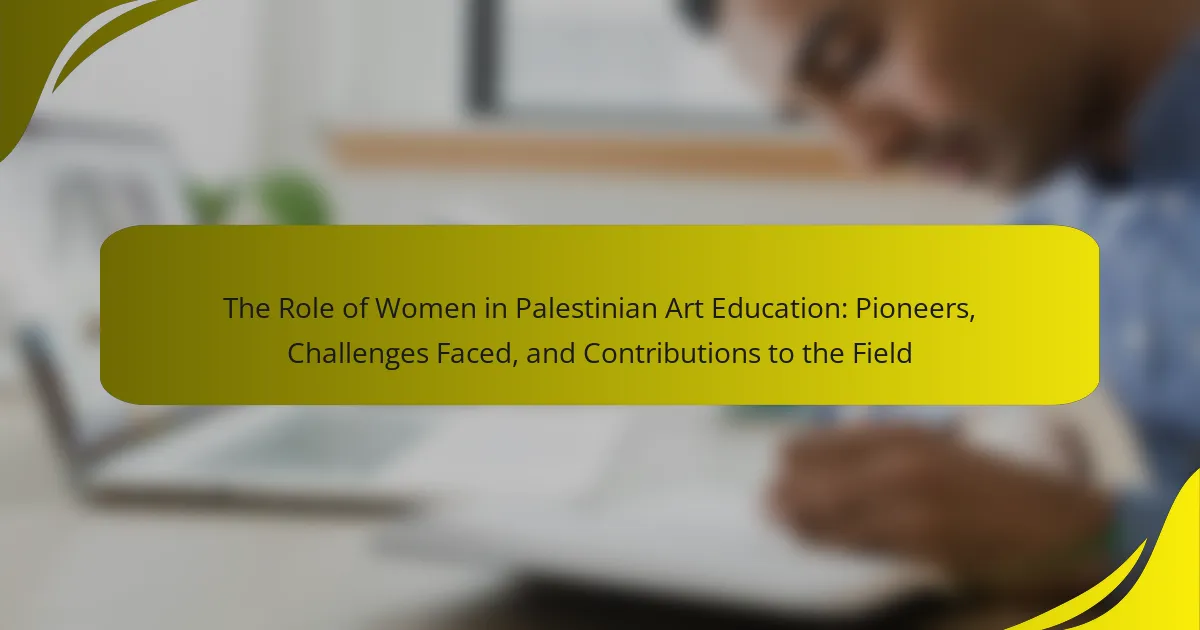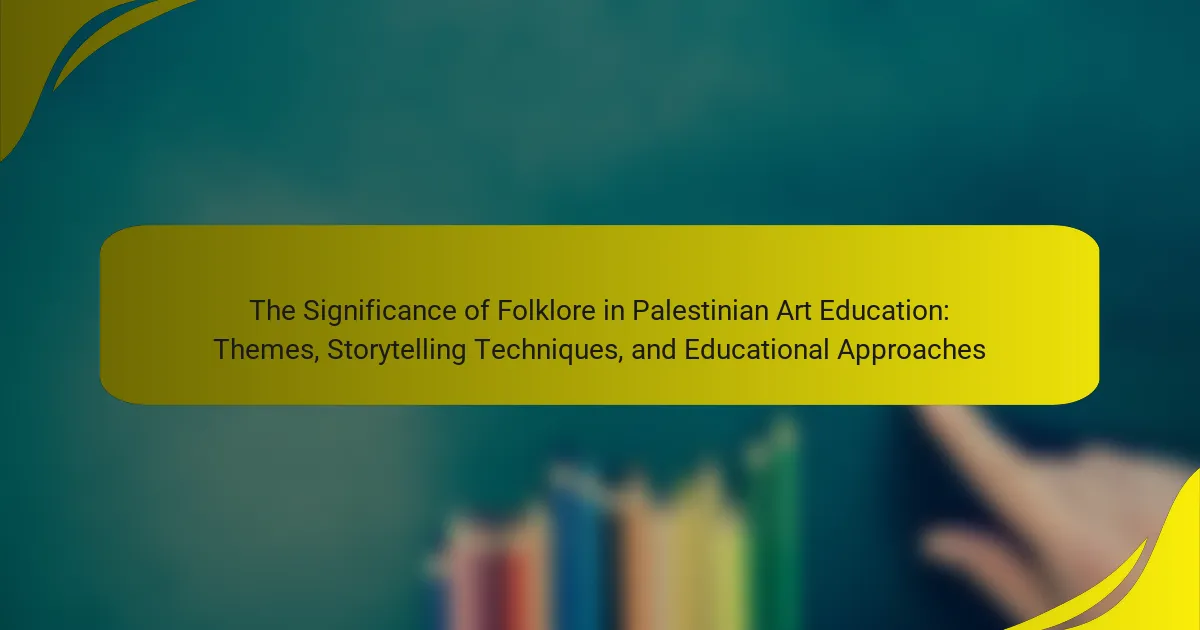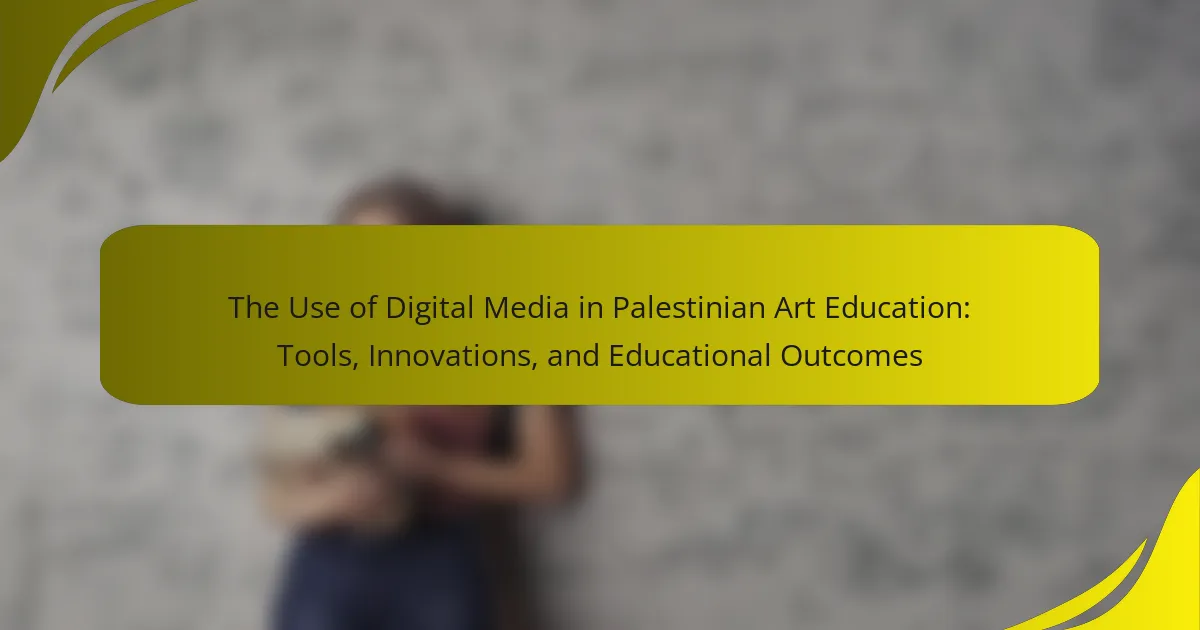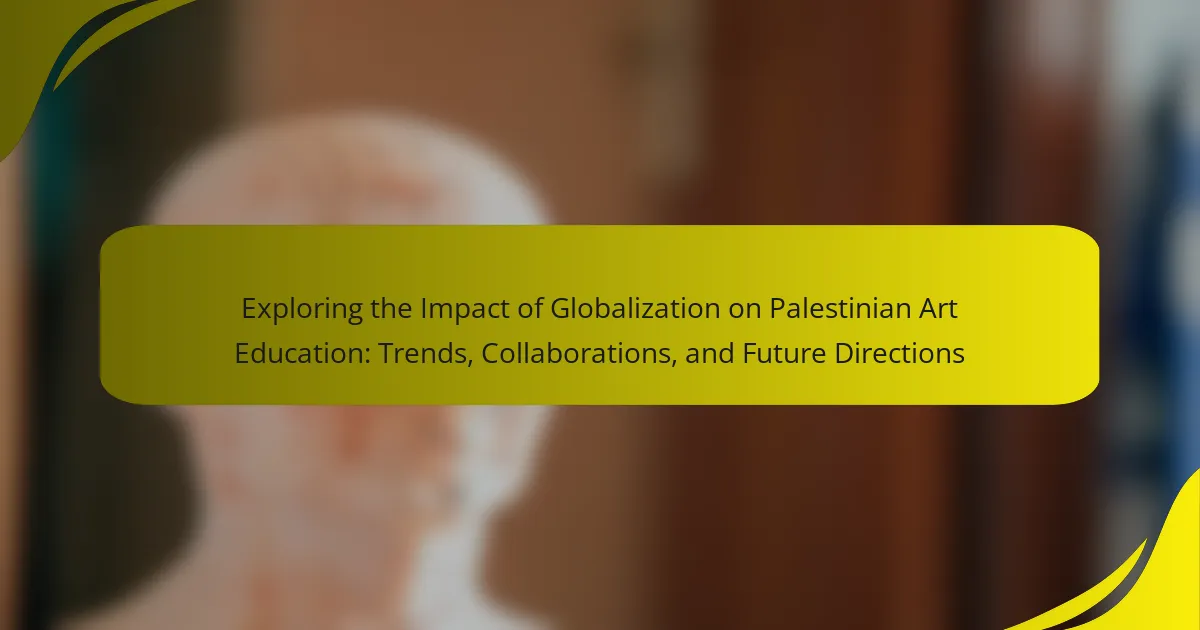The article examines the impact of political conflict on Palestinian art education, highlighting the challenges faced by educators and students in this context. Limited resources, restricted access to institutions, and a curriculum focused on survival skills hinder artistic expression. Despite these obstacles, Palestinian artists and educators show resilience by integrating local narratives into their work, fostering a unique artistic identity. The article also explores how art serves as a form of resistance and expression, reflecting socio-political themes of struggle and identity. Future prospects for Palestinian art education include the adoption of digital tools and international collaborations, which may enhance accessibility and support artistic initiatives.
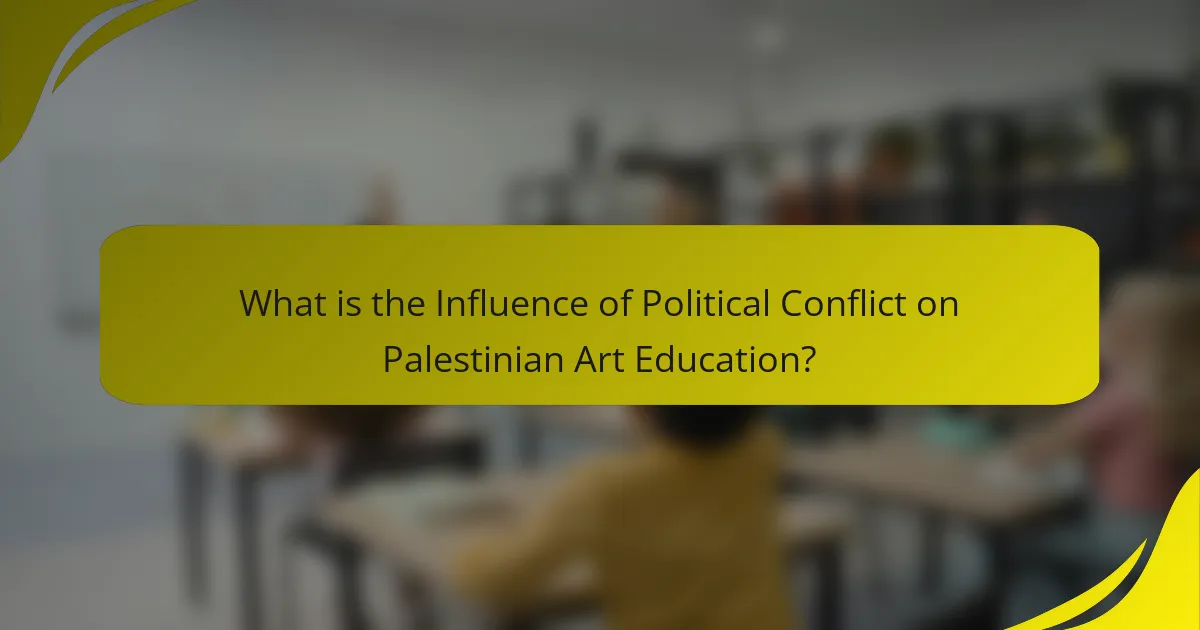
What is the Influence of Political Conflict on Palestinian Art Education?
Political conflict significantly influences Palestinian art education. It creates challenges such as limited resources and restricted access to educational institutions. The ongoing conflict affects the curriculum, often prioritizing survival skills over artistic expression. Many art educators face difficulties in providing a safe environment for creativity. Additionally, political tensions can lead to censorship of artistic content. Despite these challenges, Palestinian artists and educators demonstrate resilience. They adapt by incorporating local narratives into their art. This adaptation fosters a unique artistic identity amidst adversity. Studies indicate that art serves as a form of resistance and expression in conflict zones.
How does political conflict shape the landscape of art education in Palestine?
Political conflict significantly shapes the landscape of art education in Palestine. The ongoing conflict restricts access to resources and infrastructure necessary for effective education. Many art institutions face funding shortages due to political instability. Additionally, political tensions often lead to censorship of artistic expression. This environment can stifle creativity among students and educators. However, art education also becomes a form of resistance and resilience. Artists and educators adapt by using art as a means of social commentary. Despite challenges, initiatives emerge to promote art as a tool for healing and empowerment. This duality reflects the complex relationship between conflict and artistic expression in Palestinian society.
What historical events have impacted Palestinian art education?
The historical events impacting Palestinian art education include the Nakba of 1948 and the ongoing Israeli-Palestinian conflict. The Nakba led to the displacement of many Palestinians and disrupted traditional educational systems. This event resulted in a loss of cultural heritage and a need for new forms of artistic expression. The subsequent military occupations have restricted movement and access to resources. These restrictions hindered the development of art programs and institutions. The First and Second Intifadas further intensified the challenges faced by artists and educators. Despite these adversities, Palestinian art education has adapted through community initiatives and grassroots movements. These efforts aim to preserve cultural identity and promote artistic expression in the face of conflict.
How do current political conditions influence art curricula?
Current political conditions significantly influence art curricula by shaping themes, content, and pedagogical approaches. In regions experiencing conflict, such as Palestine, art education often reflects socio-political realities. Curricula may prioritize themes of resistance, identity, and cultural heritage. This focus aims to empower students and encourage critical thinking about their circumstances. Educational institutions may adapt by incorporating local artists and community narratives into lessons. Additionally, external political pressures can lead to censorship or limitations on artistic expression. These dynamics highlight the interconnection between art and political context in educational settings.
What are the key challenges faced by art educators in Palestine?
Art educators in Palestine face significant challenges due to ongoing political conflict. Limited resources hinder access to materials and facilities for art education. Restrictions on movement impact the ability to attend workshops and collaborate with peers. The psychological effects of conflict can affect both educators and students, leading to a lack of motivation. Additionally, censorship often restricts the themes and expressions explored in art. The curriculum may be influenced by political agendas, limiting artistic freedom. Furthermore, financial instability affects funding for art programs. These challenges collectively impede the growth and development of art education in Palestine.
How do resource limitations affect art education?
Resource limitations significantly hinder art education by restricting access to materials and facilities. Schools often lack essential supplies like paints, canvases, and tools. This scarcity limits students’ ability to explore creative techniques. Additionally, inadequate funding affects the hiring of qualified art educators. Without skilled instructors, students miss out on valuable guidance and mentorship. Resource constraints also restrict opportunities for field trips and exposure to professional art environments. Consequently, students may struggle to develop their artistic skills fully. Research by the Institute for Palestine Studies highlights how these limitations impact the overall quality of education in conflict zones.
What role does censorship play in the teaching of art?
Censorship significantly impacts the teaching of art by limiting the expression of ideas. It restricts the materials and subjects that can be explored in educational settings. This limitation can hinder creativity and critical thinking among students. In politically charged environments, such as Palestine, censorship often reflects broader societal conflicts. For instance, educators may avoid certain themes to prevent backlash or repercussions. This avoidance can lead to a lack of representation in the curriculum. Consequently, students may not fully engage with their cultural heritage or contemporary issues. The role of censorship in art education thus shapes both the content and the pedagogical approach.
What resilience strategies are employed by Palestinian art educators?
Palestinian art educators employ various resilience strategies to navigate challenges posed by political conflict. They utilize community engagement to foster support and collaboration among students and families. Art educators often incorporate local cultural themes into their curriculum to promote identity and belonging. They adapt teaching methods to accommodate limited resources and unstable environments. Many educators focus on emotional expression through art to help students process trauma. They also create safe spaces for dialogue and creativity within classrooms. Networking with international art educators enhances their skills and provides new perspectives. These strategies enable Palestinian art educators to sustain their practice despite ongoing adversity.
How do educators adapt their teaching methods in response to conflict?
Educators adapt their teaching methods in response to conflict by incorporating culturally relevant content. They often focus on themes of resilience and identity in their curriculum. This approach helps students process their experiences and emotions related to conflict. Educators may also employ collaborative learning strategies to foster a sense of community. These methods encourage students to share their perspectives and support one another. Additionally, they might integrate technology to facilitate remote learning during times of instability. Research indicates that such adaptations can enhance student engagement and learning outcomes. For instance, a study by Al-Hroub (2016) highlights the importance of context-sensitive teaching in conflict-affected areas.
What community support systems exist for art education in Palestine?
Community support systems for art education in Palestine include local NGOs, cultural centers, and community workshops. These organizations provide resources and platforms for artists and students. For example, Al-Ma’mal Foundation for Contemporary Art offers art programs and exhibitions. The Palestinian Art Court promotes legal support for artists. Additionally, community workshops foster collaboration among artists. These systems help bridge gaps caused by political conflict. They also encourage cultural expression and resilience among Palestinian youth.
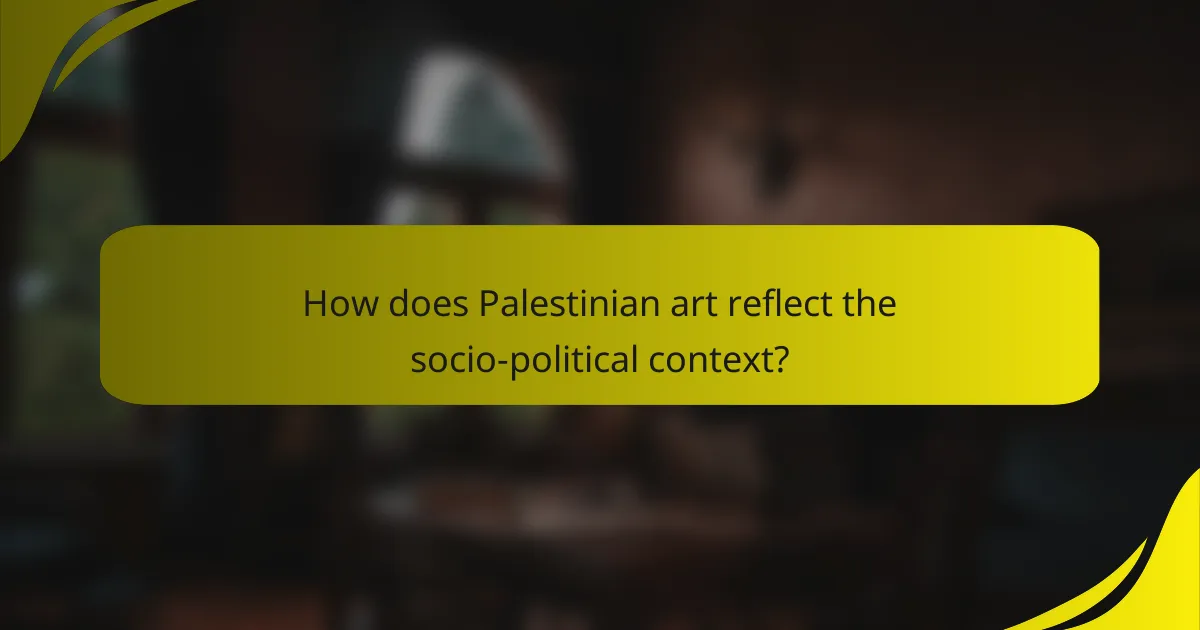
How does Palestinian art reflect the socio-political context?
Palestinian art reflects the socio-political context through themes of resistance and identity. Artists often depict the struggles faced by Palestinians due to occupation and conflict. This art serves as a form of protest against oppression. It highlights cultural heritage and the desire for self-determination. For example, murals and graffiti in urban areas express political messages. Additionally, traditional art forms are reinterpreted to convey contemporary issues. Exhibitions often focus on narratives of displacement and resilience. The socio-political landscape deeply influences the subject matter and style of the artworks. This connection is evident in both visual arts and performance.
In what ways does art serve as a form of resistance?
Art serves as a form of resistance by expressing dissent and challenging oppressive systems. It provides a platform for marginalized voices to articulate their struggles. In contexts of political conflict, such as Palestine, art reflects cultural identity and resilience. Visual art, music, and performance become tools for protest and social commentary. For example, graffiti in Palestinian territories often critiques occupation and asserts national identity. Artists use their work to raise awareness and mobilize communities. Historical instances, like the art during the Apartheid in South Africa, demonstrate art’s power in resistance movements. By documenting experiences of conflict, art preserves collective memory and fosters solidarity.
What themes are prevalent in Palestinian art related to conflict?
Palestinian art related to conflict often explores themes of resistance, identity, and loss. Resistance is depicted through imagery that symbolizes struggle against oppression. Identity is expressed by highlighting cultural heritage and the Palestinian narrative. Loss is represented through motifs of displacement and mourning. These themes reflect the ongoing socio-political realities faced by Palestinians. Artists use their work to comment on issues such as occupation and human rights violations. Historical events, such as the Nakba, are frequently referenced in artworks. The emotional impact of conflict is conveyed through various mediums, including painting, sculpture, and performance art. This artistic expression serves as a means of coping and documenting experiences of conflict.
How do artists express their identity through their work?
Artists express their identity through their work by reflecting personal experiences and cultural heritage. This expression often incorporates themes related to their background and societal issues. For Palestinian artists, their identity is closely tied to their political and social context. Many artworks address themes of displacement, resistance, and cultural resilience.
Art serves as a medium for storytelling, allowing artists to convey their narratives. Techniques such as symbolism and color choice often reflect their cultural identity. Additionally, artists may draw inspiration from traditional motifs and contemporary issues. This blend creates a unique representation of their identity.
Research indicates that art can be a form of activism. Palestinian artists often use their work to raise awareness about their struggles. This connection between identity and artistry is crucial in understanding their creative processes.
What adaptations have been made in art education due to conflict?
Art education in conflict zones has undergone significant adaptations. These adaptations include incorporating themes of resilience and identity into the curriculum. Educators have shifted to more community-based projects to foster collaboration among students. Online platforms have been utilized to facilitate remote learning and connect with global art communities. Art materials have been adapted to be accessible, often using local resources due to supply chain disruptions. Workshops and exhibitions have focused on social issues, reflecting the realities of conflict. Additionally, art therapy practices have been integrated to support mental health among students. These changes aim to empower students and promote healing through creative expression.
How has technology influenced art education in conflict zones?
Technology has significantly influenced art education in conflict zones by providing new avenues for learning and expression. Digital platforms enable remote access to art resources and online courses. This accessibility allows students to engage with global art communities. Virtual tools facilitate collaboration among artists despite geographical barriers. Social media serves as a platform for sharing artwork and gaining visibility. Moreover, technology helps document and preserve cultural heritage amid conflict. For instance, initiatives like Art Jameel and the Palestinian Museum use digital mediums to promote Palestinian art. These developments illustrate how technology can enhance resilience and adaptability in art education within conflict zones.
What innovative programs have emerged in response to challenges?
Innovative programs have emerged in Palestinian art education to address challenges posed by political conflict. Programs such as community art initiatives have been developed to foster creative expression. These initiatives aim to provide safe spaces for artists and students. Additionally, online platforms have been utilized to connect educators and learners across borders. Workshops focusing on resilience through art have also been implemented. These workshops encourage collaboration and skill development among participants. Furthermore, partnerships with international organizations have helped in resource sharing. Such collaborations enhance the quality of art education amid ongoing challenges.
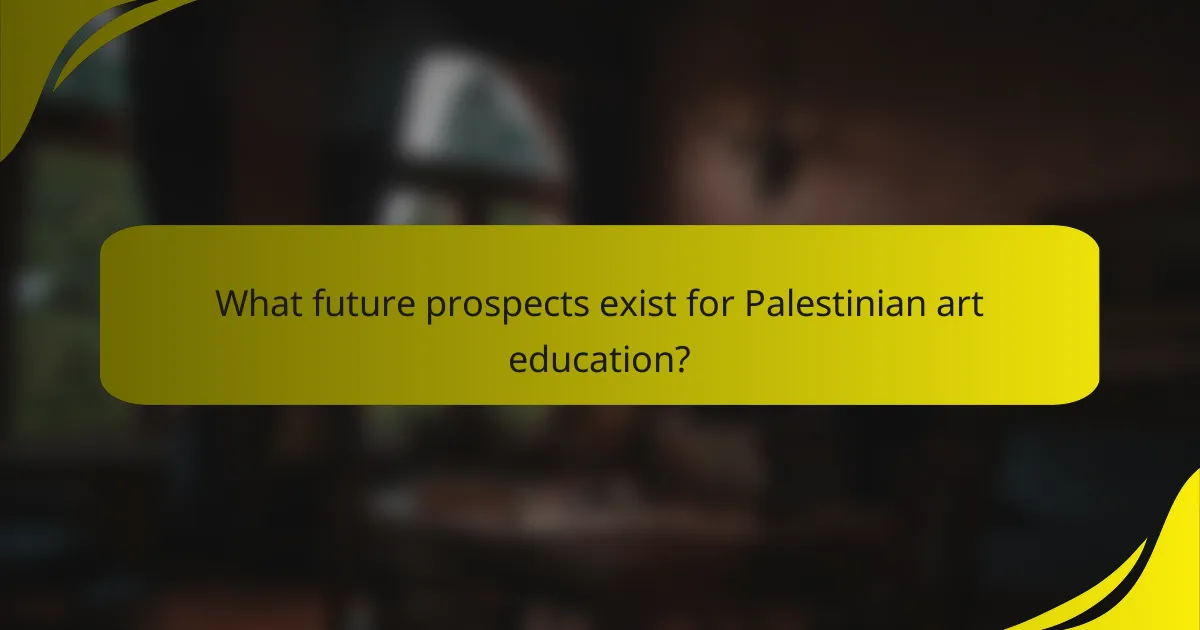
What future prospects exist for Palestinian art education?
Future prospects for Palestinian art education include increased integration of digital tools and international collaboration. These advancements can enhance accessibility and broaden the reach of Palestinian artists. Institutions are beginning to adopt online platforms for art education. This shift allows for remote learning opportunities despite political restrictions. Furthermore, partnerships with global art organizations can provide resources and training. Such collaborations can also facilitate cultural exchange programs. Increased funding from international donors may support art initiatives in Palestine. Overall, these prospects indicate a potential for growth and resilience in Palestinian art education.
How can international support enhance Palestinian art education?
International support can enhance Palestinian art education by providing funding, resources, and training. Financial assistance enables the establishment of art programs and infrastructure. Access to international art materials improves the quality of education. Collaboration with global artists introduces new techniques and perspectives. Workshops led by international experts foster skill development. Scholarships for Palestinian students create opportunities for advanced studies abroad. Exposure to international art scenes broadens cultural understanding. These elements collectively strengthen the resilience of Palestinian art education amid political challenges.
What partnerships can be formed to promote art education?
Partnerships that can be formed to promote art education include collaborations with local schools, universities, and art institutions. These partnerships can facilitate resource sharing and curriculum development. Nonprofit organizations focused on education can also play a crucial role. They can provide funding and support for art programs. Additionally, collaborations with government agencies can help secure necessary permits and funding. Art galleries and museums can offer exhibition opportunities for student work. Private sector partnerships can lead to sponsorships and mentorship programs. Community organizations can engage local artists to lead workshops. Each of these partnerships enhances access to art education and resources in challenging environments.
How can art education contribute to peacebuilding efforts?
Art education can contribute to peacebuilding efforts by fostering dialogue and understanding among diverse communities. It encourages critical thinking and empathy through creative expression. Engaging in art allows individuals to share personal narratives and cultural identities. This sharing can bridge divides and reduce tensions. Research shows that art initiatives in conflict zones promote social cohesion. For instance, programs in Palestine have utilized art to address trauma and build community resilience. Such initiatives demonstrate the transformative power of art in promoting peace and collaboration.
What best practices can be adopted for effective art education in conflict areas?
Adopting community-based approaches is a best practice for effective art education in conflict areas. These approaches foster collaboration among local artists, educators, and community members. They create a supportive environment that encourages participation and engagement. Integrating culturally relevant content enhances the relevance of the curriculum. This ensures that students connect their art to their lived experiences. Providing safe spaces for expression is crucial. Such spaces allow students to explore their emotions and thoughts freely. Additionally, utilizing technology can bridge gaps in resources. Online platforms can facilitate remote learning and access to diverse artistic influences. Training educators in trauma-informed practices is essential. This equips them to address the psychological needs of students affected by conflict. Lastly, establishing partnerships with NGOs can provide necessary resources and support. These partnerships can enhance the sustainability of art programs in challenging contexts.
How can educators engage students in meaningful artistic expression?
Educators can engage students in meaningful artistic expression by creating a safe and supportive environment. This allows students to explore their emotions and experiences through art. Incorporating culturally relevant themes can make the art more relatable. Encouraging collaboration among students fosters a sense of community. Providing diverse materials and techniques can inspire creativity. Regular feedback helps students refine their artistic skills. Additionally, connecting art projects to real-world issues enhances relevance and impact. Research shows that art education can improve critical thinking and emotional resilience in students.
What resources are available for art educators in Palestine?
Art educators in Palestine have access to various resources. These include local NGOs that support arts education. Organizations like the Al-Qattan Foundation provide training and funding. The Palestinian Ministry of Education offers curriculum guidelines and workshops. Art educators can also access online platforms for teaching materials. Collaborative projects with international art institutions are available as well. Local universities provide art education programs and research opportunities. Community art initiatives foster collaboration and resource sharing among educators. These resources aim to enhance the quality of art education despite ongoing challenges.
The primary entity of this article is Palestinian art education and its dynamics influenced by political conflict. The article examines the challenges faced by art educators, including limited resources, censorship, and the impact of historical events such as the Nakba and ongoing conflicts. It highlights the resilience of educators and artists who adapt their curricula to reflect local narratives and themes of resistance. Additionally, the article explores community support systems, innovative programs, and the role of technology in enhancing art education amid adversity. Overall, it emphasizes how art serves as a medium for expression and resistance within the socio-political context of Palestine.
